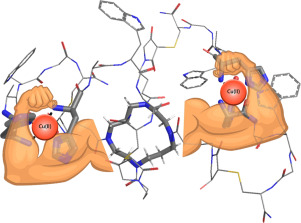当前位置:
X-MOL 学术
›
J. Inorg. Biochem.
›
论文详情
Our official English website, www.x-mol.net, welcomes your feedback! (Note: you will need to create a separate account there.)
Cu(II) coordination to His-containing linear peptides and related branched ones: Equalities and diversities.
Journal of Inorganic Biochemistry ( IF 3.9 ) Pub Date : 2020-01-03 , DOI: 10.1016/j.jinorgbio.2019.110980 Monica Perinelli 1 , Remo Guerrini 2 , Valentina Albanese 2 , Nicola Marchetti 2 , Denise Bellotti 2 , Silvia Gentili 1 , Matteo Tegoni 1 , Maurizio Remelli 2
Journal of Inorganic Biochemistry ( IF 3.9 ) Pub Date : 2020-01-03 , DOI: 10.1016/j.jinorgbio.2019.110980 Monica Perinelli 1 , Remo Guerrini 2 , Valentina Albanese 2 , Nicola Marchetti 2 , Denise Bellotti 2 , Silvia Gentili 1 , Matteo Tegoni 1 , Maurizio Remelli 2
Affiliation

|
The two branched peptides (AAHAWG)4-PWT2 and (HAWG)4-PWT2 where synthesized by mounting linear peptides on a cyclam-based scaffold (PWT2), provided with four maleimide chains, through a thio-Michael reaction. The purpose of this study was primarily to verify if the two branched ligands had a Cu(II) coordination behavior reproducing that of the single-chain peptides, namely AAHAWG-NH2, which bears an Amino Terminal Cu(II)- and Ni(II)-Binding (ATCUN) Motif, and HAWG-NH2, which presents a His residue as the N-terminal amino acid, in a wide pH range. The study of Cu(II) binding was performed by potentiometric, spectroscopic (UV-vis absorption, CD, fluorescence) and ESI-MS techniques. ATCUN-type ligands ((AAHAWG)4-PWT2 and AAHAWG-NH2) were confirmed to bind one Cu(II) per peptide fragment at both pH 7.4 and pH 9.0, with a [NH2, 2N-, NIm] coordination mode. On the other hand, the ligand HAWG-NH2 forms a [CuL2]2+ species at neutral pH, while, at pH 9, the formation of 1:2 Cu(II):ligand adducts is prevented by amidic nitrogen deprotonation and coordination, to give rise solely to 1:1 species. Conversely, Cu(II) binding to (HAWG)4-PWT2 resulted in the formation of 1:2 copper:peptide chain also at pH 9: hence, through the latter branched peptide we obtained, at alkaline pH, the stabilization of a specific Cu(II) coordination mode which results unachievable using the corresponding single-chain peptide. This behavior could be explained in terms of high local peptide concentration on the basis of the speciation of the Cu(II)/single-chain peptide systems.
中文翻译:

Cu(II)与含His的线性肽及相关分支肽的配位:均一性和多样性。
两个支链肽(AAHAWG)4-PWT2和(HAWG)4-PWT2通过将线性肽通过thio-Michael反应安装在具有四个马来酰亚胺链的基于Cyclam的支架(PWT2)上而合成。这项研究的目的主要是为了验证两个支链配体是否具有与单链肽(AAHAWG-NH2)相同的Cu(II)配位行为,该配体具有氨基末端Cu(II)-和Ni(II )(ATCUN)基序和HAWG-NH2,在宽的pH范围内,该残基以His残基为N端氨基酸。Cu(II)结合的研究是通过电位,光谱(紫外可见吸收,CD,荧光)和ESI-MS技术进行的。确认ATCUN型配体((AAHAWG)4-PWT2和AAHAWG-NH2)在pH 7.4和pH 9.0时均与每个肽片段结合一个Cu(II)与[NH2,2N- NIm]协调模式。另一方面,配体HAWG-NH2在中性pH下形成[CuL2] 2+物种,而在pH 9时,酰胺氮去质子化和配位阻止了1:2 Cu(II):配体加合物的形成,仅产生1:1物种。相反,Cu(II)与(HAWG)4-PWT2的结合也导致在pH 9时也形成了1:2的铜:肽链:因此,通过后者的支链肽,我们在碱性pH下获得了稳定的特定Cu(II)配位模式,使用相应的单链肽无法实现。此行为可以根据Cu(II)/单链肽系统的形态高局部肽浓度来解释。酰胺氮的去质子化和配位可防止配体加合物仅产生1:1的物种。相反,Cu(II)与(HAWG)4-PWT2的结合也导致在pH 9时也形成了1:2的铜:肽链:因此,通过后者的支链肽,我们在碱性pH下获得了稳定的特定Cu(II)配位模式,使用相应的单链肽无法实现。此行为可以根据Cu(II)/单链肽系统的形态高局部肽浓度来解释。酰胺氮的去质子化和配位可防止配体加合物仅产生1:1的物种。相反,Cu(II)与(HAWG)4-PWT2的结合也导致在pH 9时也形成了1:2的铜:肽链:因此,通过后者的支链肽,我们在碱性pH下获得了稳定的特定Cu(II)配位模式,使用相应的单链肽无法实现。此行为可以根据Cu(II)/单链肽系统的形态高局部肽浓度来解释。在碱性pH下,特定Cu(II)配位模式的稳定化是使用相应的单链肽无法实现的。此行为可以根据Cu(II)/单链肽系统的形态高局部肽浓度来解释。在碱性pH下,特定Cu(II)配位模式的稳定化是使用相应的单链肽无法实现的。这种行为可以根据Cu(II)/单链肽系统的形态高局部肽浓度来解释。
更新日期:2020-01-04
中文翻译:

Cu(II)与含His的线性肽及相关分支肽的配位:均一性和多样性。
两个支链肽(AAHAWG)4-PWT2和(HAWG)4-PWT2通过将线性肽通过thio-Michael反应安装在具有四个马来酰亚胺链的基于Cyclam的支架(PWT2)上而合成。这项研究的目的主要是为了验证两个支链配体是否具有与单链肽(AAHAWG-NH2)相同的Cu(II)配位行为,该配体具有氨基末端Cu(II)-和Ni(II )(ATCUN)基序和HAWG-NH2,在宽的pH范围内,该残基以His残基为N端氨基酸。Cu(II)结合的研究是通过电位,光谱(紫外可见吸收,CD,荧光)和ESI-MS技术进行的。确认ATCUN型配体((AAHAWG)4-PWT2和AAHAWG-NH2)在pH 7.4和pH 9.0时均与每个肽片段结合一个Cu(II)与[NH2,2N- NIm]协调模式。另一方面,配体HAWG-NH2在中性pH下形成[CuL2] 2+物种,而在pH 9时,酰胺氮去质子化和配位阻止了1:2 Cu(II):配体加合物的形成,仅产生1:1物种。相反,Cu(II)与(HAWG)4-PWT2的结合也导致在pH 9时也形成了1:2的铜:肽链:因此,通过后者的支链肽,我们在碱性pH下获得了稳定的特定Cu(II)配位模式,使用相应的单链肽无法实现。此行为可以根据Cu(II)/单链肽系统的形态高局部肽浓度来解释。酰胺氮的去质子化和配位可防止配体加合物仅产生1:1的物种。相反,Cu(II)与(HAWG)4-PWT2的结合也导致在pH 9时也形成了1:2的铜:肽链:因此,通过后者的支链肽,我们在碱性pH下获得了稳定的特定Cu(II)配位模式,使用相应的单链肽无法实现。此行为可以根据Cu(II)/单链肽系统的形态高局部肽浓度来解释。酰胺氮的去质子化和配位可防止配体加合物仅产生1:1的物种。相反,Cu(II)与(HAWG)4-PWT2的结合也导致在pH 9时也形成了1:2的铜:肽链:因此,通过后者的支链肽,我们在碱性pH下获得了稳定的特定Cu(II)配位模式,使用相应的单链肽无法实现。此行为可以根据Cu(II)/单链肽系统的形态高局部肽浓度来解释。在碱性pH下,特定Cu(II)配位模式的稳定化是使用相应的单链肽无法实现的。此行为可以根据Cu(II)/单链肽系统的形态高局部肽浓度来解释。在碱性pH下,特定Cu(II)配位模式的稳定化是使用相应的单链肽无法实现的。这种行为可以根据Cu(II)/单链肽系统的形态高局部肽浓度来解释。



























 京公网安备 11010802027423号
京公网安备 11010802027423号